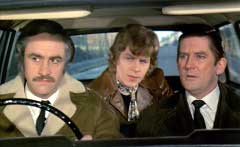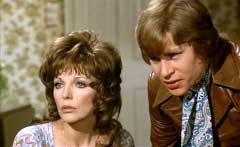 KATARINA’S
NIGHTMARE THEATER: REVENGE (1971)
KATARINA’S
NIGHTMARE THEATER: REVENGE (1971)Director: Sidney Hayers
Scorpion Releasing
 KATARINA’S
NIGHTMARE THEATER: REVENGE (1971)
KATARINA’S
NIGHTMARE THEATER: REVENGE (1971)No sooner has Jim Radford (James Booth, ZULU) buried his youngest daughter Jenny – found raped and murdered in a dump – than he learns from fellow grieving father Harry (Ray Barrett, DON’S PARTY) that the police have released likely suspect Seely (Kenneth Griffith, THE LION IN WINTER) due to lack of evidence. Jim is open to the possibility that Seely may be innocent; however, Harry takes him with him on a surveillance trip that reveals that Seely’s long-way-around trip to the shops passes the school (where he has been caught offering children sweets) and that there is an alley behind Seely’s house that leads to the dump where the bodies of their daughters were found. With Jim’s son Lee (Tom Marshall, KILLER’S MOON), they plot to abduct Seely and get him to confess before handing him over to the police (or killing him). They grab him and drag him into the cellar beneath Jim’s pub and beat him, but things get out of hand when Jim’s wife Carol (Joan Collins, FEAR IN THE NIGHT) also gets involved and Jim seemingly kills Seely. Before they can get rid of him, they discover that he’s still alive. Harry urges Jim to kill Seely, but he cannot and would rather leave him in the cellar and let him die on his own. The family try to go about their lives despite the suspicions of Jim’s teenage daughter Jill (Zuleika Robson, LET’S GET LAID), Lee’s strained relationship with barmaid Rose (Sinead Cusack, STEALING BEAUTY), Harry’s sudden “business trip” when things get difficult, Jim’s drinking, and the investigation of Seely’s abduction being conducted by a sly inspector (Donald Morley).

Also known as AFTER JENNY DIED, REVENGE is less of a gothic horror film – suggested by some of the other alternate titles such as INN OF THE FRIGHTEND PEOPLE, BEHIND THE CELLAR DOOR or TERROR FROM UNDER THE HOUSE – than a tense, realistic thriller. It is not a reactionary “what would you do if…” film; it’s more of a “don’t take the law into your own hands” story with a twist rather than a moralizing ending. Even without the dark secret in the basement, things are already tense in the family. Jim is too busy playing peacekeeper between daughter Jill and her stepmother Carol to face his own feelings of sadness and rage (which makes Seely the perfect target). Former barmaid Carol blames herself for being late to pick up Jenny from school. She knows Jill blames her – in addition to blaming her for her mother and father splitting up – thinks that Jim blames her, and sends mixed messages to her stepson by turning to him for comfort and confidence. Lee seems to be the more stable one until the abduction; after which he finds it difficult to go on as normal. It’s understandable that his clueless girlfriend might interpret his unusual lack of interest as a temporary impotence; however, to hear the same thing from his stepmother – who is well aware of the secret in the basement – is enough to give any guy a complex. Even Jill is a bit of a brat who goads Carol with variations of both “you’re not my real mother” and “if you were my real mother, you’d…” The most sympathetic characters are Lee’s clueless girlfriend Rose and, seemingly, the accused child murderer (despite the circumstantial evidence pointing to his guilt, and the creepy shrine to his mother).

Cinematographer Ken Hodges’ (THE RULING CLASS) frequently camera frames three to four of the guilt-ridden main characters in alternately cozy and claustrophobic group shots across the width and depth of the frame. Hodges also manages some neat shots from Seely’s point of view as he is punched by all three of the men, and sees a topless Collins through the nudity-obscuring effect of his smashed glasses. The score of Eric Rogers is subtly employed, and the more tense moments are unscored (Rogers composed and conducted the scores for virtually all of REVENGE producer Peter Rogers’s [no relation] prolific CARRY ON films). Collins is more sympathetically scripted here than usual, and her shrill moments are pretty justified; however, Booth is given the most developed character, and he is effective as a seemingly level-headed man whose explosive anger is responsible for much of what goes wrong (including consenting to the abduction in the first place). Cusack sadly has little to do here other than look wounded at her boyfriend’s cold behavior.
 Director
Sidney Hayers’ had previously dabbled in the horror genre with CIRCUS
OF HORRORS and the well-received BURN, WITCH, BURN (NIGHT OF THE EAGLE), a Richard
Matheson adaptation of Fritz Leiber’s “Conjure Wife.” Hayers’
next film for producer Peter Rogers and executive producer George Brown (also
written by REVENGE’s John Kruse): ASSAULT – which also had several
alternate titles attached to it such as TOWER OF TERROR, IN THE DEVIL’S
GARDEN, SATAN’S PLAYTHINGS and the video retitle THE CREEPERS –
with its schoolgirls as prey to a rapist plotline, would make a good double
bill with REVENGE. He followed these two productions up with the Peter Rogers
thriller ALL COPPERS ARE… the nifty thriller DIAGNOSIS: MURDER (with Christopher
Lee), and the must-see suspenser DEADLY STRANGERS with Haley Mills and Simon
Ward. After directing a handful of episodes of THE NEW AVENGERS, Hayers went
to America and directed episodes of several action and suspense shows from KNIGHT
RIDER and THE A-TEAM to the new DRAGNET and BAYWATCH before his death in 2000.
The interesting supporting cast also includes Barry Andrews (BLOOD ON SATAN’S
CLAW) as a smirking police sergeant, Geoffrey Hughes (TV’s KEEPING UP
APPEARANCES) and Patrick McAlinney (A NIGHT TO REMEMBER).
Director
Sidney Hayers’ had previously dabbled in the horror genre with CIRCUS
OF HORRORS and the well-received BURN, WITCH, BURN (NIGHT OF THE EAGLE), a Richard
Matheson adaptation of Fritz Leiber’s “Conjure Wife.” Hayers’
next film for producer Peter Rogers and executive producer George Brown (also
written by REVENGE’s John Kruse): ASSAULT – which also had several
alternate titles attached to it such as TOWER OF TERROR, IN THE DEVIL’S
GARDEN, SATAN’S PLAYTHINGS and the video retitle THE CREEPERS –
with its schoolgirls as prey to a rapist plotline, would make a good double
bill with REVENGE. He followed these two productions up with the Peter Rogers
thriller ALL COPPERS ARE… the nifty thriller DIAGNOSIS: MURDER (with Christopher
Lee), and the must-see suspenser DEADLY STRANGERS with Haley Mills and Simon
Ward. After directing a handful of episodes of THE NEW AVENGERS, Hayers went
to America and directed episodes of several action and suspense shows from KNIGHT
RIDER and THE A-TEAM to the new DRAGNET and BAYWATCH before his death in 2000.
The interesting supporting cast also includes Barry Andrews (BLOOD ON SATAN’S
CLAW) as a smirking police sergeant, Geoffrey Hughes (TV’s KEEPING UP
APPEARANCES) and Patrick McAlinney (A NIGHT TO REMEMBER).
 Released
on DVD in the UK in an open-matte transfer, Scorpion’s Region 1 disc of
REVENGE is its first widescreen presentation (at 1.66:1); alas, it is not an
anamorphic presentation (which is just as well since the 16:9 masters of some
of ITV’s Rank Organization-licensed titles look like upscales that make
hash of the enhanced detail an anamorphic transfer should have offered); that
said, the dual-layer, progressive transfer is attractive with seemingly accurate
colors (a lot of the clothing and set detail is muted, but Jenny’s red
coat really pops when it is in frame [prefiguring a surprise at the end]) and
the matted image is well-framed. The Dolby Digital mono audio is in good condition;
Eric Rogers’ score does not have the bombastic presence that his score
for Hayer’s ASSAULT had, but the dialogue comes through clearly. Sadly,
there are no extras for the film (Collins really ought to talk about some of
her early 1970s work, as it is a lot less embarrassing than some of her later
work (pre- and post-DYNASTY). The film is playable with optional introduction
by hostess Katarina Leigh Waters, who provides information on the alternate
titles – including the “terror teeth” given away with TERROR
FROM UNDER THE HOUSE version – and the main cast members (the editor,
however, mistook a close-up of Zuleika Robson for Sinead Cusack). In addition
to the trailers for Norman J. Warren’s TERROR, DOUBLE EXPOSURE, THE SURVIVOR,
NOTHING BUT THE NIGHT, THE DEVIL WITHIN HER (also with Collins), SATAN’S
SLAVE, THE HOUSE ON SORORITY ROW, HUMONGOUS and QUEST FOR LOVE (another Peter
Rogers production with Collins), there is the usual promo reel of Katarina titles
(with clips for THE SURVIVOR an DOUBLE EXPOSURE appended to the titles seen
on the reel in previous releases). (Eric
Cotenas)
Released
on DVD in the UK in an open-matte transfer, Scorpion’s Region 1 disc of
REVENGE is its first widescreen presentation (at 1.66:1); alas, it is not an
anamorphic presentation (which is just as well since the 16:9 masters of some
of ITV’s Rank Organization-licensed titles look like upscales that make
hash of the enhanced detail an anamorphic transfer should have offered); that
said, the dual-layer, progressive transfer is attractive with seemingly accurate
colors (a lot of the clothing and set detail is muted, but Jenny’s red
coat really pops when it is in frame [prefiguring a surprise at the end]) and
the matted image is well-framed. The Dolby Digital mono audio is in good condition;
Eric Rogers’ score does not have the bombastic presence that his score
for Hayer’s ASSAULT had, but the dialogue comes through clearly. Sadly,
there are no extras for the film (Collins really ought to talk about some of
her early 1970s work, as it is a lot less embarrassing than some of her later
work (pre- and post-DYNASTY). The film is playable with optional introduction
by hostess Katarina Leigh Waters, who provides information on the alternate
titles – including the “terror teeth” given away with TERROR
FROM UNDER THE HOUSE version – and the main cast members (the editor,
however, mistook a close-up of Zuleika Robson for Sinead Cusack). In addition
to the trailers for Norman J. Warren’s TERROR, DOUBLE EXPOSURE, THE SURVIVOR,
NOTHING BUT THE NIGHT, THE DEVIL WITHIN HER (also with Collins), SATAN’S
SLAVE, THE HOUSE ON SORORITY ROW, HUMONGOUS and QUEST FOR LOVE (another Peter
Rogers production with Collins), there is the usual promo reel of Katarina titles
(with clips for THE SURVIVOR an DOUBLE EXPOSURE appended to the titles seen
on the reel in previous releases). (Eric
Cotenas)